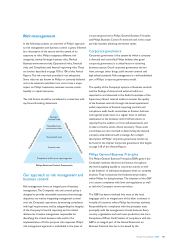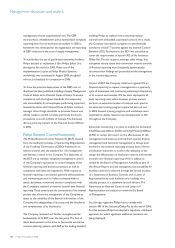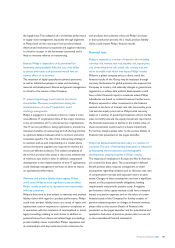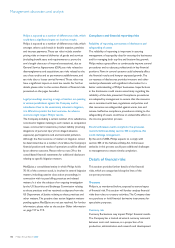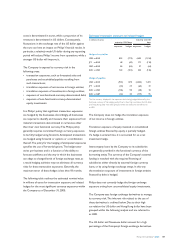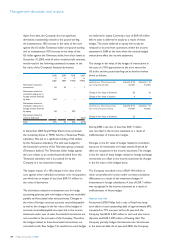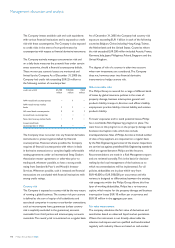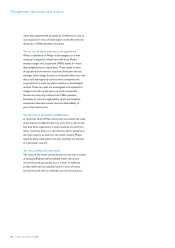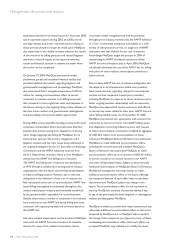Philips 2005 Annual Report Download - page 109
Download and view the complete annual report
Please find page 109 of the 2005 Philips annual report below. You can navigate through the pages in the report by either clicking on the pages listed below, or by using the keyword search tool below to find specific information within the annual report.Philips Annual Report 2005 109
had three USD interest rate swaps outstanding, on which
the Company pays fi xed interest on the equivalent of
EUR 145 million. The results on these interest rate swaps
are recognized in the income statement.
Certain past interest rate hedges related to bonds were
unwound during 2004. The fair value adjustments to the
bonds is amortized to the income statement based on the
recalculated effective yield. In 2005, a gain of EUR 5 million
was released to the income statement. No results were
released to the income statement as a result of
ineffectiveness of interest rate hedges in 2005.
As of December 31, 2005, the majority of debt consisted
of bonds. Of the EUR 3,320 million of long-term debt, 7%
consisted of bonds with a so-called ‘embedded put’ feature,
which allows the investor to ask for redemption of the
bonds within a specifi c one-month period prior to the
redemption date specifi ed within the option.
A sensitivity analysis shows that if long-term interest rates
were to decrease instantaneously by 1% from their level
of December 31, 2005, with all other variables (including
foreign exchange rates) held constant, the fair value of the
long-term debt would increase by approximately EUR 131
million. If there was an increase of 1% in long-term interest
rates, this would reduce the market value of the long-term
debt by approximately EUR 131 million.
If interest rates were to increase instantaneously by 1%
from their level of December 31, 2005, with all other
variables held constant, the net interest expense would
decrease by approximately EUR 39 million in 2006 due to
the signifi cant cash position of the Company. This impact is
based on the outstanding position at December 31, 2005.
Liquidity risk
The rating of the Company’s debt by major rating services
may improve or deteriorate. As a result, the Company’s
borrowing capacity may be infl uenced and its fi nancing costs
may fl uctuate. Philips has various sources to mitigate the
liquidity risk for the Company including EUR 5,293 million
in cash and short-term deposits, a USD 2,500 million
Commercial Paper Program and a USD 2,500 million
committed revolving facility that acts as back-up for short-
term fi nancing requirements that would normally be
satisfi ed through the Commercial Paper Program and
EUR 11,218 million of investments in its main available-
for-sale securities and unconsolidated listed companies
at market value per 31 December 2005. The Company
has lock-up periods associated to the sale of shares in
some of its shareholdings in listed unconsolidated
companies. These lock-up periods, with their associated
expiry dates, exist for LG.Philips LCD (February 2006),
FEI (February 2006), TSMC (December 2006) and TPV
(September 2008). Furthermore, within the LG.Philips LCD
shareholders
agreement with LG Electronics, there is an
agreement that both companies will maintain a holding
of at least 30% each until July 2007.
Equity price risk
Philips is a shareholder in several publicly listed companies
such as TSMC, LG.Philips LCD, FEI, TPV and JDS Uniphase.
Philips also holds options on the shares of TPV and
Nuance within convertible bonds issued to Philips by
these companies. As a result, Philips is exposed to equity
price risk through movements in the share prices of these
companies. The aggregate equity price exposure of these
investments, excluding the options with the convertible
bonds, amounted to approximately EUR 11,218 million
at year-end 2005 (2004: EUR 10,950 million including
shares that were sold during 2005). Philips does not hold
derivatives in its own stock, or in the above mentioned
listed companies except for the embedded derivatives
in the convertible bonds as mentioned.
Commodity price risk
The Company is a purchaser of certain base metals (such
as copper), precious metals and energy. The Company
hedges certain commodity price risks using derivative
instruments to minimize signifi cant, unanticipated earnings
fl uctuations caused by commodity price volatility. The
commodity price derivatives that the Company enters
into are concluded as cash fl ow hedges to offset forecasted
purchases. A 10% increase in the market price of all
commodities would increase the fair value of the derivatives
by less than EUR 1 million.
Credit risk
Credit risk represents the loss that would be recognized
at the reporting date if counterparties failed completely
to perform their payment obligations as contracted. Credit
risk is present within the trade receivables of the Company,
but as of December 31, 2005 there are no individual customers
with signifi cant outstanding receivables. To reduce exposure
to credit risk, the Company performs ongoing credit
evaluations of the fi nancial condition of its customers
and
adjusts payment terms and credit limits when appropriate.




